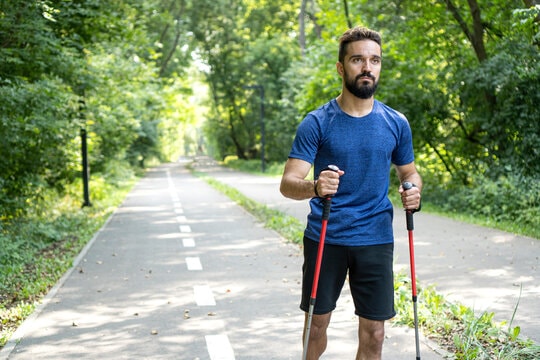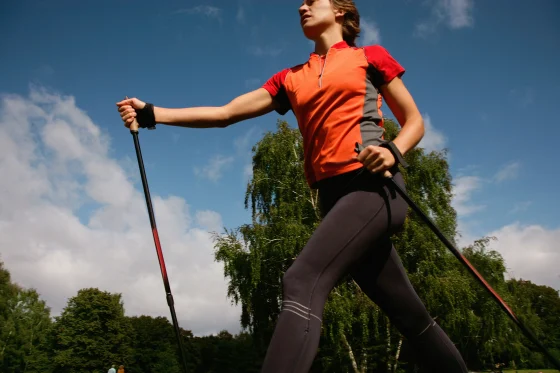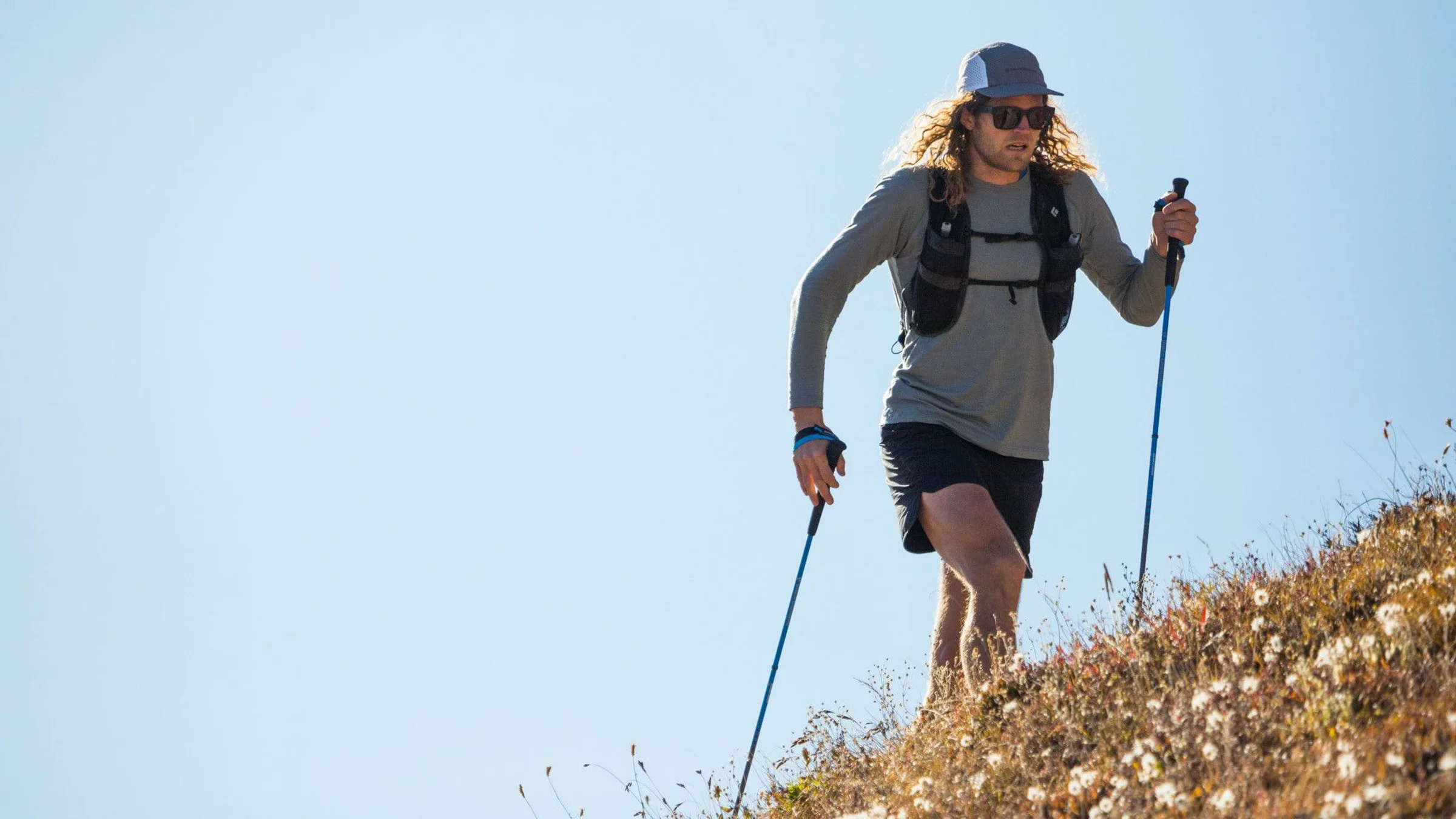When selecting Nordic walking poles, the right choice can make all the difference in your fitness routine. Whether you’re a seasoned walker or just starting out, the right poles can enhance your experience by providing stability, improving your technique, and boosting your overall workout. Choosing the right poles can prevent strain and injuries, ensuring a more enjoyable and effective walking session. This guide will delve into the key factors to consider, ensuring you find the perfect pair to support your Nordic walking journey.
From materials and features to fit and adjustments, we’ll cover everything you need to know to make an informed decision. Understanding the nuances of pole construction and the importance of proper sizing will help you select Nordic walking poles that cater to your specific needs. By comprehending these essentials, you’ll be equipped to maximize comfort and effectiveness, ultimately leading to a more rewarding and enjoyable walking experience.
Choosing the Right Poles: Your Guide to Selecting Nordic Walking Poles

Selecting Nordic walking poles is a critical step in ensuring the most effective workout and preventing injury. The correct poles can improve your walking stability, distribute exercise benefits across your body, and enhance the cardiovascular gains of your walks.
Determining the ideal pole for you involves understanding the key factors that influence the comfort, efficiency, and safety of your Nordic walking experience. To select suitable Nordic walking poles, you must consider their length, material, grip, strap design, and the type of tips or endcaps they come with.
The length of the poles should reflect your height to maintain proper posture and technique. Materials range from aluminum to carbon, each offering different levels of strength and flexibility to suit various preferences and terrains. Additionally, the grip and strap of the poles must ensure a secure hold without causing discomfort, allowing for the natural movement of your hands.
Key Takeaways
- Choose poles based on your height and the material’s suitability for your walking style. Proper length and material enhance comfort and effectiveness.
- Ensure the grip and strap provide a secure, comfortable hold to support your hands and wrists during walks, preventing discomfort and enhancing control.
- Select tips and endcaps that match your walking surface for optimal performance and durability. Different tips are designed for various terrains.
- Decide between adjustable poles for versatility or fixed-length poles for consistent support. Each has its benefits based on your needs.
- Consider reputable brands and price ranges to find quality poles that fit your budget and requirements. Higher-priced poles often offer advanced features and better materials.
Understanding Nordic Walking Poles
To successfully engage in Nordic walking, choosing the right poles is crucial. It’s not just about the poles themselves, but the history behind them and their design, which contribute to the effectiveness of your workout.
History and Evolution of Nordic Walking
Nordic walking started as a summer training regimen for cross-country skiers. Over time, it evolved into a recognized fitness activity beneficial for individuals of all fitness levels. The poles, initially derived from ski equipment, have since been adapted for specific use in Nordic walking. Innovations in material and design have made them more user-friendly and efficient.
Anatomy of Nordic Walking Poles
Nordic Walking Poles consist of several key components to consider when selecting Nordic walking poles.
- Shaft: Made from materials like aluminum or carbon, the shaft’s weight and durability affect performance.
- Grip: The handle, usually ergonomic, affects comfort and control.
- Strap: Assists in securing your hand to the pole; options vary from simple loops to advanced glove-like designs.
- Tip: It comes in different shapes for various terrains; it has a sharp tip for off-road and a rubber pad for pavement.
- Adjustability: Poles may be fixed-length or adjustable, offering more versatility.
Recognizing these aspects will aid you in selecting poles that match your height and walking style.
Determining the Correct Length

Choosing the correct length for your Nordic walking poles is critical to ensure proper technique and comfort during your walk.
Height-Based Guidelines
Your height is the primary factor in determining the length of your Nordic walking poles. A general formula to calculate your correct pole length is multiplying your height in centimeters by 0.68. For example, if you are 172cm tall, you’d need a pole that is about 117cm (Height Based Calculation). For fixed-length poles, round this number up or down to the nearest 5cm to find your ideal size.
Adjustable Vs. Fixed-length Poles
Adjustable Poles:
Selecting Nordic walking poles allows you to fine-tune the length based on your height and the terrain you’re walking on. These poles offer versatility and can be shared among users of different heights.
Fixed-Length Poles:
These are typically lighter and have less vibration than adjustable poles. Once you have determined your correct size, these poles provide consistent support without needing adjustments. Choosing the correct size from the start is essential, as these cannot be adjusted later.
Selecting the Right Material
Your Nordic walking poles’ material is crucial in their durability, weight, and overall performance. When selecting Nordic walking poles, it’s essential to choose a material that complements your walking style and terrain preferences.
Aluminum Poles
Aluminum poles are known for their durability and cost-effectiveness. They generally weigh between 18 and 22 ounces per pair, with variations based on the pole gauge, which ranges from 12 to 16 mm.
Aluminum is an excellent choice if you prioritize strength over lightness. Their robust nature makes them less likely to break under stress, ideal for rocky and challenging terrains. Learn more about aluminum poles.
Carbon Fiber Poles
Carbon fiber poles are prized for lightweight properties, often weighing less than their aluminum counterparts. However, they can be more expensive. Carbon fiber’s main advantage is the significant weight reduction, which can help reduce arm fatigue over long distances.
These poles are best suited for the lightest option, especially useful in well-maintained trails or for competitive Nordic walking. Explore the properties of carbon fiber.
Composite Materials
Poles made from composite materials aim to balance weight and strength. They are typically constructed from a blend of carbon fiber and aluminum, which helps mitigate the brittleness of carbon while still being lighter than pure aluminum poles.
Composite poles can be a great “middle-ground” option if you’re looking for durability without the total weight of aluminum. They are versatile for various trails, whether walking on gentle slopes or uneven surfaces.
Did You Know?
The required pole length varies between Nordic walking and Nordic skiing. Nordic skiing poles are generally longer than walking poles to assist with the gliding motion of skis. The pole size for each activity is calculated differently based on the specific body mechanics involved.
Check out this video for a guide on selecting the perfect Nordic walking pole for you.
By: Nordic Walk Store
Grip and Strap Considerations

Selecting Nordic walking poles requires attention to the grip and strap design. These elements significantly impact your walking comfort and effectiveness.
Types of Grips
Your grip on the Nordic walking poles is crucial for control and comfort. Fixed grips are standard and provide stability. However, if you prefer flexibility, adjustable grips allow you to change the hand position for different terrains or personal preferences.
The material of the grip also matters. You can find grips made of rubber, which are durable and weather-resistant. For those who value comfort and moisture absorption, cork handles are a beneficial choice, as they conform to the shape of your hand over time.
Strap Materials and Designs
The straps are not just for keeping the poles attached to your hands; they aid in transferring power from your arms to the poles. Straps come in various materials, such as nylon, which is solid and durable, or neoprene, known for its comfort and cushioning effect.
In terms of design, some Nordic walking poles come with simple loop straps, while others feature ergonomic demi-gloves that distribute pressure more evenly across your hands. When selecting straps, prioritize those with adjustable and breathable fabric to ensure both a snug fit and ventilation.
Pole Tips and Endcaps
Selecting Nordic walking poles involves choosing the right pole tips and endcaps, which can significantly affect your Nordic walking experience by enhancing durability and improving grip on various terrains.
Single-Point Tips
Single-point tips on Nordic walking poles provide precision and stability on soft ground. These tips are often pointed and made of hard materials like carbide to pierce through surfaces such as dirt or grass. They’re designed to give you a secure anchor point with each stride, thus reducing slippage and enhancing your walking rhythm.
Angled and Rubber Tips
Angled and rubber tips are best suited for hard and smooth surfaces, such as paved roads or sidewalks. The angled design aims to increase the contact area, improve grip, and reduce wear. Meanwhile, rubber tips offer shock absorption, reducing the impact on your joints. They also help to silence the noise of the poles striking the ground, making for a more pleasant walking experience.
Brands and Pricing

When selecting Nordic walking poles, you’ll consider the brand reputation and price closely. When selecting Nordic walking poles, recognizing the best fit for your needs and budget can significantly enhance your walking experience.
Popular Brands
LEKI and Swix are among the leading brands in the Nordic walking pole market. They are renowned for their quality and durability, which is essential for a consistent walking routine.
LEKI poles often come with their proprietary Trigger Shark system for optimal grip and comfort, and Swix promises technology-driven designs for improved performance. Other notable brands include Exel, known for pioneering carbon composite poles, and Komperdell, which features innovative shock absorption systems.
Price Range and Quality Indicators
Nordic walking poles can range from approximately $30 to over $150. Generally, the price correlates with specific quality indicators:
- Under $50: Poles at this price are typically adjustable and made from aluminum, suitable for beginners.
- $50 to $100: You often find fixed-length poles with carbon composite construction, balancing weight and durability.
- Over $100: High-end poles are usually lighter and stronger and employ the latest technologies for comfort and efficiency. You’re paying for features like seamless adjustment systems, advanced grip designs, and superior construction materials.
Maintenance and Care
Maintaining your Nordic walking poles ensures they remain functional and safe for use. Regular cleaning and part replacement prevent wear when selecting Nordic walking poles and enhance their longevity.
Cleaning and Storage
To clean your Nordic walking poles:
- Wipe them down with a damp cloth to remove dirt and sweat after each use.
- Ensure they’re dry before collapsing them for storage.
- Avoid exposing the poles to extreme temperatures or moisture when not in use, as this can damage the material and mechanisms.
It’s best to store them in a cool, dry place away from direct sunlight.
Replacing Worn Parts
Inspect your poles regularly, paying attention to the tips and grips, which can wear down with frequent use. Many Nordic walking poles have replaceable tips, so check with the manufacturer or refer to guides such as How to Choose Your Nordic Walking Poles for information on buying and fitting replacements.
If you notice any cracks or severe wear in the poles themselves, it’s time to consider purchasing new ones for your safety.
Making Your Purchase

When you’re ready to buy Nordic walking poles, selecting Nordic walking poles from a reliable retailer is crucial. It’s important to understand the policies that will protect your purchase.
Where to Buy
You can purchase Nordic walking poles sporting goods stores, specialized fitness shops, and online marketplaces.
For a tailored experience and expert advice, specialty fitness shops like Decathlon often provide a diverse range of models and brands. Online retailers offer convenience and sometimes broader selections with potentially better deals.
Warranty and Return Policies
Before finalizing your purchase, always check the warranty and return policies. Reliable warranties demonstrate the manufacturer’s confidence in their product and protect your investment. Look for warranties that cover at least one year to safeguard against defects.
Additionally, ensure the retailer offers a straightforward return policy. This provides you with the peace of mind that you can return the poles if they don’t meet your expectations or if you encounter any issues.
Check out this video on how to choose the right Nordic walking poles.
By: SIKANA English
Mastering Your Walk: A Comprehensive Guide to Selecting Nordic Walking Poles
Selecting Nordic walking poles is a vital aspect of optimizing your fitness routine and ensuring a safe, enjoyable walking experience. The right poles can significantly enhance stability, improve technique, and contribute to overall workout effectiveness. They provide the necessary support for proper posture and technique, which can lead to more efficient and enjoyable walks. By understanding the key factors such as length, material, grip, and tips, walkers can make informed decisions that prevent strain and promote comfort.
The choice of Nordic walking poles involves more than just picking any set from the store. It requires considering how different materials, adjustability, and design features align with personal needs and preferences. Selecting poles that fit well and match your walking style is crucial for maximizing performance and minimizing discomfort. With the right knowledge and considerations, individuals can select poles that support their Nordic walking journey, leading to a more rewarding and effective fitness regimen.
Frequently Asked Questions
How Do I Determine the Correct Length of Nordic Walking Poles for My Height?
A general rule is to multiply your height by 0.68 centimeters to choose Nordic walking poles that fit your height. For practical advice, you can also view a demonstration on selecting the correct Nordic Walking pole size.
What Are the Key Features to Consider When Purchasing Nordic Walking Poles?
Essential features include the pole material, adjustability, grip type, wrist strap comfort, and whether the pole has an anti-shock system. For more information, look at how to choose your Nordic walking poles.
Can Regular Trekking Poles Be Used for Nordic Walking, and if Not, Why?
Standard trekking poles are not recommended for Nordic walking because they lack specific design features such as angled handles and specialized tips for the sport. Understand the differences in depth in this guide on using walking poles correctly.
What is the Proper Technique for Using Nordic Walking Poles?
The correct technique includes keeping the poles angled backward, planting them slightly behind you, and using a coordinated arm swing. For a step-by-step guide on the method, including arm swing and pole drag, visit Nordic walking techniques.
What is the Most Effective Way to Use Trekking Poles During a Hike?
Effective use of trekking poles during a hike involves adjusting the length for uphill and downhill sections. This will provide better balance and support. You should also sync the pole plant with the opposite foot for a natural gait.
Stay Energized and Flourishing: Become a Part of the Fit After 55 Community!
Explore a world of fitness inspiration with Fit After 55!
Head to our website (https://www.vitalityseniorliving.com/resources_for_senior/staying-fit-at-55/) for engaging content, expert tips, and reviews specifically for seniors. Connect with our encouraging community on Facebook (https://www.facebook.com/fitafter50dotcom/) and connect with others dedicated to maintaining an active and healthy lifestyle.
Let’s start this fitness journey together—because age is just a number!
Explore Further
Nordic Walking Challenges: Set Goals for Better Health
Safe Nordic Walking: Essential Guidelines for Secure Strides
Nordic Walking Gear Essentials: The Complete Accessory Guide
Nordic Walking and Bone Health: Strides Against Osteoporosis
